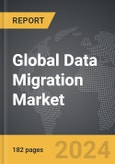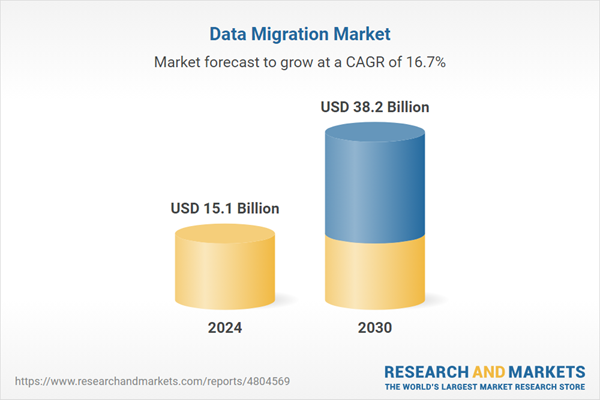Global Data Migration Market - Key Trends and Drivers Summarized
What Is Data Migration and Why Is It Crucial for Modern Businesses?
Data migration is the process of transferring data between storage systems, formats, or computer systems, a key task for businesses undergoing digital transformations, system upgrades, or consolidations. As organizations strive to stay competitive by adopting newer and more efficient technologies, data migration becomes essential for ensuring that critical business data can move seamlessly from old systems to new ones without loss or corruption. This process not only involves the physical moving of data but also its conversion and integration into new system architectures. Effective data migration is crucial for maintaining the integrity and availability of data, which supports operational continuity and helps businesses leverage their data assets to gain strategic insights and operational efficiencies.How Are Advanced Technologies Enhancing Data Migration Processes?
The evolution of data migration processes has been significantly influenced by advancements in technology, particularly with the advent of cloud computing and big data analytics. Modern data migration tools and services now offer more robust functionalities, including automation features that minimize manual efforts and reduce the risk of errors during the migration process. These tools can automatically detect and rectify inconsistencies or corruption in data before, during, and after migration, ensuring that data remains accurate and reliable. Furthermore, the use of machine learning algorithms in migration tools allows for predictive analysis of migration issues, enabling proactive measures to mitigate potential problems. The integration of these technologies not only streamlines the migration process but also enhances security measures, which are critical when handling sensitive or proprietary data.What Challenges Do Organizations Face During Data Migration?
Data migration is fraught with challenges that can pose significant risks to its success. One of the primary challenges is data loss or corruption, which can occur if the migration is not handled carefully. Ensuring data integrity involves meticulous planning and testing, which can be resource-intensive. Compatibility issues between old and new systems can also present significant hurdles, especially when dealing with legacy systems that may not easily integrate with modern platforms. Additionally, the downtime required to perform the migration can disrupt business operations, leading to potential revenue losses. To overcome these challenges, organizations often need to invest in specialized migration expertise and technologies that can increase the complexity and cost of the project.What Drives the Growth in the Data Migration Market?
The growth in the data migration market is driven by several factors, including the increasing volume of data being generated by businesses and the rapid pace of technological advancements. As companies accumulate vast amounts of data, the need for scalable, more efficient, and more secure storage solutions grows, prompting many to migrate data to cloud-based platforms. The shift towards digital transformation initiatives also propels the need for data migration, as businesses seek to modernize their IT infrastructures to support new applications and improve operational efficiencies. Additionally, the expansion of data privacy regulations globally is compelling companies to migrate data to systems that offer better compliance features. Economic factors, such as the need to reduce IT operational costs and enhance data accessibility and management, also contribute significantly to the demand for data migration solutions. These drivers, coupled with the increasing awareness of the benefits of having an agile and data-centric IT infrastructure, ensure robust growth in the data migration market, highlighting its importance in the digital economy.Report Scope
The report analyzes the Data Migration market, presented in terms of market value (USD). The analysis covers the key segments and geographic regions outlined below.- Segments: Data Type (Customer Data, Financial Data, Product Data, Compliance Data, Supplier Data); Business Function (Marketing, Sales, Finance, Legal, Other Business Functions).
- Geographic Regions/Countries: World; United States; Canada; Japan; China; Europe (France; Germany; Italy; United Kingdom; and Rest of Europe); Asia-Pacific; Rest of World.
Key Insights:
- Market Growth: Understand the significant growth trajectory of the Customer Data Migration segment, which is expected to reach US$14 Billion by 2030 with a CAGR of 18.8%. The Financial Data Migration segment is also set to grow at 16.9% CAGR over the analysis period.
- Regional Analysis: Gain insights into the U.S. market, valued at $4.1 Billion in 2024, and China, forecasted to grow at an impressive 15.3% CAGR to reach $5.7 Billion by 2030. Discover growth trends in other key regions, including Japan, Canada, Germany, and the Asia-Pacific.
Why You Should Buy This Report:
- Detailed Market Analysis: Access a thorough analysis of the Global Data Migration Market, covering all major geographic regions and market segments.
- Competitive Insights: Get an overview of the competitive landscape, including the market presence of major players across different geographies.
- Future Trends and Drivers: Understand the key trends and drivers shaping the future of the Global Data Migration Market.
- Actionable Insights: Benefit from actionable insights that can help you identify new revenue opportunities and make strategic business decisions.
Key Questions Answered:
- How is the Global Data Migration Market expected to evolve by 2030?
- What are the main drivers and restraints affecting the market?
- Which market segments will grow the most over the forecast period?
- How will market shares for different regions and segments change by 2030?
- Who are the leading players in the market, and what are their prospects?
Report Features:
- Comprehensive Market Data: Independent analysis of annual sales and market forecasts in US$ Million from 2024 to 2030.
- In-Depth Regional Analysis: Detailed insights into key markets, including the U.S., China, Japan, Canada, Europe, Asia-Pacific, Latin America, Middle East, and Africa.
- Company Profiles: Coverage of players such as Amazon Web Services, Inc., Attunity Ltd., IBM Corporation, Informatica LLC, Information Builders, Inc. and more.
- Complimentary Updates: Receive free report updates for one year to keep you informed of the latest market developments.
Some of the 13 companies featured in this Data Migration market report include:
- Amazon Web Services, Inc.
- Attunity Ltd.
- IBM Corporation
- Informatica LLC
- Information Builders, Inc.
- Microsoft Corporation
- Oracle Corporation
- SAP SE
- SAS Institute, Inc.
- Scribe Software Inc.
- Syncsort
- Talend SA
This edition integrates the latest global trade and economic shifts into comprehensive market analysis. Key updates include:
- Tariff and Trade Impact: Insights into global tariff negotiations across 180+ countries, with analysis of supply chain turbulence, sourcing disruptions, and geographic realignment. Special focus on 2025 as a pivotal year for trade tensions, including updated perspectives on the Trump-era tariffs.
- Adjusted Forecasts and Analytics: Revised global and regional market forecasts through 2030, incorporating tariff effects, economic uncertainty, and structural changes in globalization. Includes historical analysis from 2015 to 2023.
- Strategic Market Dynamics: Evaluation of revised market prospects, regional outlooks, and key economic indicators such as population and urbanization trends.
- Innovation & Technology Trends: Latest developments in product and process innovation, emerging technologies, and key industry drivers shaping the competitive landscape.
- Competitive Intelligence: Updated global market share estimates for 2025, competitive positioning of major players (Strong/Active/Niche/Trivial), and refined focus on leading global brands and core players.
- Expert Insight & Commentary: Strategic analysis from economists, trade experts, and domain specialists to contextualize market shifts and identify emerging opportunities.
Table of Contents
Companies Mentioned (Partial List)
A selection of companies mentioned in this report includes, but is not limited to:
- Amazon Web Services, Inc.
- Attunity Ltd.
- IBM Corporation
- Informatica LLC
- Information Builders, Inc.
- Microsoft Corporation
- Oracle Corporation
- SAP SE
- SAS Institute, Inc.
- Scribe Software Inc.
- Syncsort
- Talend SA
Table Information
| Report Attribute | Details |
|---|---|
| No. of Pages | 182 |
| Published | December 2025 |
| Forecast Period | 2024 - 2030 |
| Estimated Market Value ( USD | $ 15.1 Billion |
| Forecasted Market Value ( USD | $ 38.2 Billion |
| Compound Annual Growth Rate | 16.7% |
| Regions Covered | Global |









